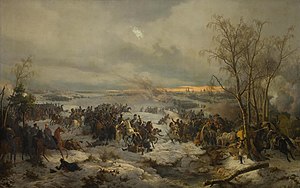Battle of Krasnoye
| Battle of Krasnoi | |||||||
|---|---|---|---|---|---|---|---|
| Part of Napoleon's invasion of Russia | |||||||
 Battle of Krasnoi, by Peter von Hess |
|||||||
|
|||||||
| Belligerents | |||||||
|
|
|
||||||
| Commanders and leaders | |||||||
|
|
|
||||||
| Strength | |||||||
| 42,000 regulars, 39,000 stragglers |
60,000–80,000 | ||||||
| Casualties and losses | |||||||
| 6,000–13,000 killed, 20,000–26,000 captured ~ (almost all stragglers) |
2,000–5,000 | ||||||
Coordinates: 54°33′36″N 31°25′48″E / 54.56000°N 31.43000°E
The Battle of Krasnoi (Krasny) (November 15 to 18, 1812) was a series of skirmishes fought in the final stage of Napoleon's retreat from Moscow. The Russians under General Mikhail Illarionovich Kutuzov inflicted heavy losses on the remnants of the Grande Armée. Lacking sufficient artillery, cavalry and supplies to wage battle, Napoleon's objective at Krasnoi was to collect his scattered troops and to resume his retreat. Despite the vast superiority of his forces, Kutuzov refrained from launching a full-scale offensive during the four days of fighting.
The climax of the engagement occurred on November 17, when an aggressive feint by the French Imperial Guard induced Kutuzov to delay a potentially decisive final Russian attack. Napoleon was thus able to withdraw part of his army before the Russians seized Krasnoi.
Despite Napoleon's success in saving part of his army from destruction at Krasnoi, overall the encounter was ruinous for the French. During the four days of combat Napoleon's subordinate commanders suffered heavy defeats in individual actions, and large numbers of French stragglers were captured by the Russians. The Grande Armée was also compelled to abandon much of its remaining artillery and baggage train.
After departing from Moscow on October 18 with 100,000 combat-ready but undersupplied troops, Napoleon's strategic object was to quarter his army for the winter at the closest French supply depot, which was at Smolensk, 430 kilometres (270 mi) to the west. During the three-week march to Smolensk, however, the Grande Armée was devastated by a combination of factors: cold, starvation, demoralization, breakdown in troop discipline, a crippling loss of horses and essential supplies, attacks from the Russian army and constant harassment by its Cossack irregulars and partisans.
...
Wikipedia
